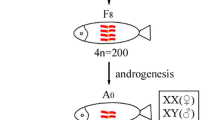Abstract.
Sex evolution has been a debating focus in evolutionary genetics. In lower vertebrates of reptiles, amphibians, and fish, a species or a bioform reproduces either sexually or asexually but never both. A few species were found to consist of all females in fish. These all-female species can propagate by asexual reproduction modes, such as gynogenesis and hybridogenesis. However, the coexistence of sexuality and asexuality in a single species was recently noted only in a cyprinid fish silver crucian carp, Carassius auratus gibelio. This fish had been demonstrated to be capable of gynogenesis stimulated by sperm from other related species. Surprisingly, natural populations of this fish consist of a minor but significant portion (approx. 20%) of males. As different clones with specific phenotypic and genetic characteristics have been found, and RAPD markers specific to each clone have recently been identified, this fish offers many advantages for analyzing whether or not genetic recombination occurs between different clones. In this study, artificial propagation was performed in clone F and clone D. Ovulated eggs from clone F were divided into two parts and respectively inseminated with sperm from a clone D male and from a red common carp (Cyprinus carpio) male. The control clone D individuals were selected from gynogenetic offspring of clone D activated by sperm of red common carp. The phenotype and sex ratio in the experimental groups were also observed. Using RAPD molecular markers, which allow for reliable discrimination and genetic analysis of different clones, we have revealed direct molecular evidence for gonochoristic reproduction in the gynogenetic silver crucian carp and confirmed a previous hypothesis that the silver crucian carp might reproduce both gynogenetically and gonochoristically. Therefore, we conclude that the silver crucian carp possesses two reproductive modes, i.e., gynogenetic and gonochoristic reproduction. The response mechanism of two reproductive development modes may be the first discovery in vertebrates. Additionally, we discuss the evolutionary implication between gynogenetic and gonochoristic reproduction modes and the contribution of the minor proportion of males to genetic flexibility in the gynogenetic silver crucian carp.
Similar content being viewed by others
Author information
Authors and Affiliations
Additional information
Received: 5 January 2000 / Accepted: 3 August 2000
Rights and permissions
About this article
Cite this article
Zhou, L., Wang, Y. & Gui, JF. Genetic Evidence for Gonochoristic Reproduction in Gynogenetic Silver Crucian Carp (Carassius auratus gibelio Bloch) as Revealed by RAPD Assays. J Mol Evol 51, 498–506 (2000). https://doi.org/10.1007/s002390010113
Issue Date:
DOI: https://doi.org/10.1007/s002390010113




